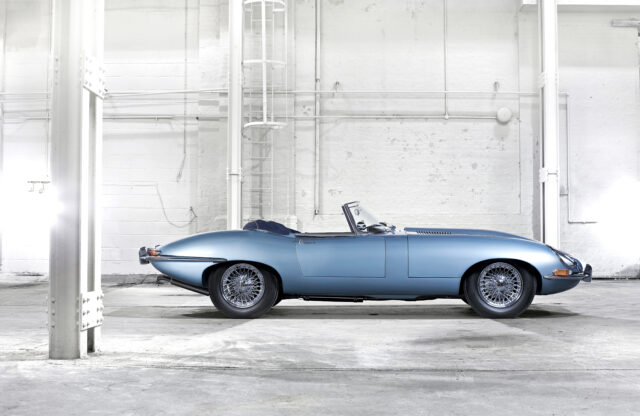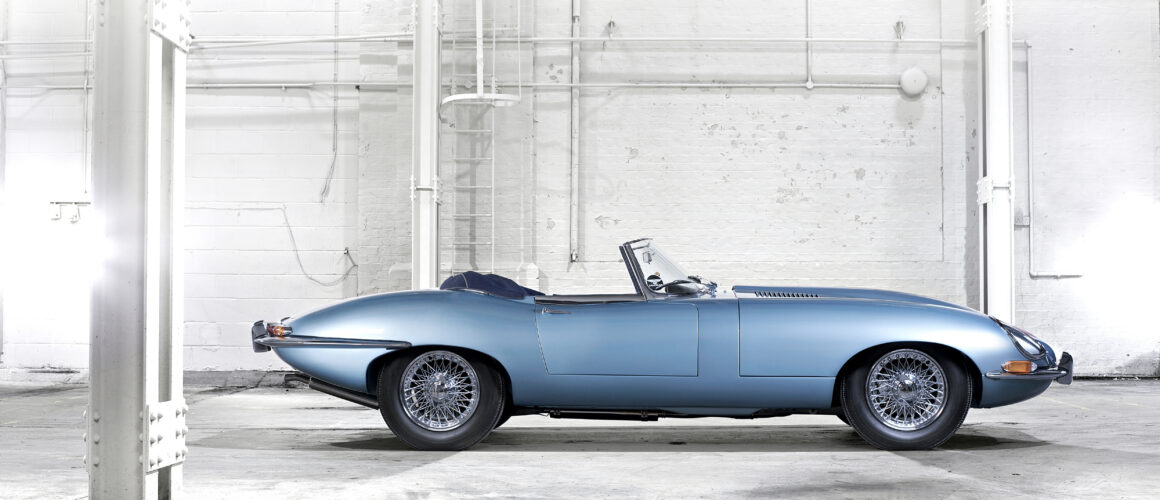The greatest motor car of all time. The most iconic classic car ever. Sensational. Unique. Ahead of its time. Take your pick. Every description is fair. The Jaguar E-type is still lauded decades since its launch at 4.30pm at the Parc Des Eaux Vives in Geneva on 15 March 1961.
The E-type stunned the world with its futuristic and curvaceous styling, its advanced mechanical specifications and real world price of £2256. To say that the automotive press was shocked at the first sighting of the E-type Jaguar is an understatement. The Malcolm Sayer design was simply unlike any motor car ever seen – achingly beautiful but clearly also absolutely functional.
The design, engineering and creation of the E-type was one of the greatest steps forward for the automotive industry in the decade. The 1960s was a time of revolution, liberation and innovation, with the E-type right there leading the changes. It’s become a mobile cliché of the Swinging Sixties; Mike Myers’ ‘Shaguar’ E-type in the Austin Powers movies was supposedly inspired by ’60s heart-throb Simon Dee driving away with the blonde in the E-type at the end of his TV chat show, Dee Time.
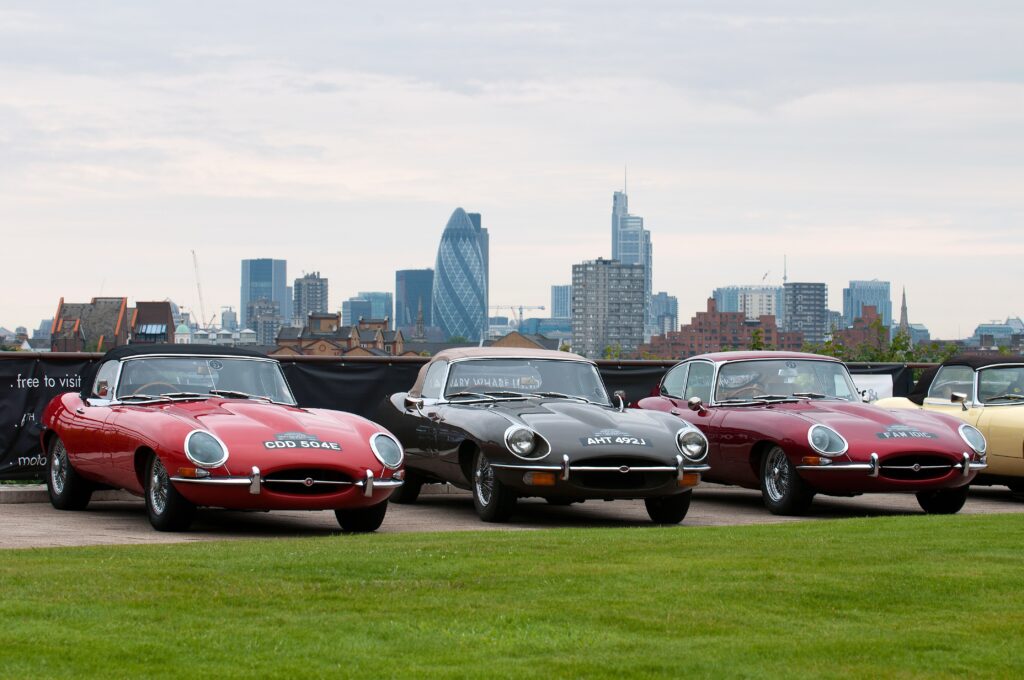
Real-life celebrity owners such as footballer George Best (‘I spent a lot of money on booze, birds and fast cars. The rest I just squandered…’) gave the E-type a louche, caddish image that was probably the last thing Sir William Lyons intended and yet was ironically in keeping with Jaguar’s well-established reputation as ‘the Bentley of Wardour Street’ – a thoroughfare in the heart of London’s Soho that in the 1950s was a synonym for sleaze and vulgarity.
Which brings us to the crux of the matter, the E-type’s looks. Men and women are shallow creatures when it comes to judging by appearances, and the E-type has that kind of immediately accessible sex appeal that will never go out of fashion. Even the Italians were impressed: Enzo Ferrari reputedly called it ‘the most beautiful car ever made’ – though one suspects that, like most great quotes, this one may not be entirely reliable.
Great looks, fab engine; shame about the brakes, seats and gearbox. OK, that’s being slightly harsh, but despite the fantastic vision of the design, the E-type’s execution was flawed even by the standards of 1961. The brakes were discs all round – good – but they weren’t up to keeping a hard-driven 140mph-plus E-type in check – bad. The simple bucket seats were not terribly comfortable and there wasn’t enough room for taller drivers, while the Moss gearbox was as slow and obstructive as it had always been in previous XKs. Rumour has it that it was designed for a pre-war truck.

On the other hand, the independent rear suspension was a genuine innovation (take that, Ferrari, with your beam rear axles – pah!) that gave the E-type a comfortable ride and superb roadholding. And that was a key reason why E-types could be raced, and win, straight out of the box, as drivers such as Graham Hill, Roy Salvadori and many more immediately proved. Jaguar’s reputation for building cars that really shifted without rattling the occupants’ fillings started with the E-type.
With looks, pace, power, engineering and heritage, the Jaguar also offered an extra quality – relative affordability. While Aston Martin, Ferrari, Porsche et al had worthy rivals, they were much more costly. That price differential has remained; a superb E-type can now be valuable, but an equivalent DB4 or 250GT will cost rather more.
Which Jaguar E-type to buy?
It’s easy to overlook the differences between the various iterations of E-type, but they’re highly significant. Buy the wrong car and you’ll wonder what all the fuss is about. Also, don’t get taken in by the glamour of the roadster when the coupé is more affordable and every bit as good to drive.
Generally, the earlier the E-type, the more desirable and expensive it is. Later cars do offer something more of a relaxed GT experience, while the earlier cars are the more sporting and focused driving machines. Which one you go for really depends on how you intend on using your classic Jaguar.

There’s also the question of originality. The E-type is one of the most receptive classic cars to upgrades, and most cars will have received a few modifications along the way. If you’re not too fussed about the car retaining every original detail, then there are many new parts that can improve reliability, performance and drivability. A few companies also offer cars ready built to more modern usable standards, such as Eagle.
Original right-hand-drive cars are a lot rarer than you’d think. Around 85 per cent of production was exported, so many right-hand-drive cars have been converted from left-hand drive at some point. Just ensure the car you buy is what it claims to be. Check it has the correct engine and that it’s not a roadster, which left the factory as a coupé. The Jaguar Daimler Heritage Trust is invaluable in providing details of the car’s original spec.
If the car does need work there’s no need to fret about parts availability, because everything is available to revive an E-type, no matter how tired. With the right tools and enough time, a competent home mechanic can tackle just about any job that’s likely to crop up.
Few cars at any price are as rewarding to own or drive as a well-restored E-type. And there’s the rub; it must be properly renovated if it is to give any pleasure – and there’s a huge amount of enjoyment to be gained from E-type ownership.
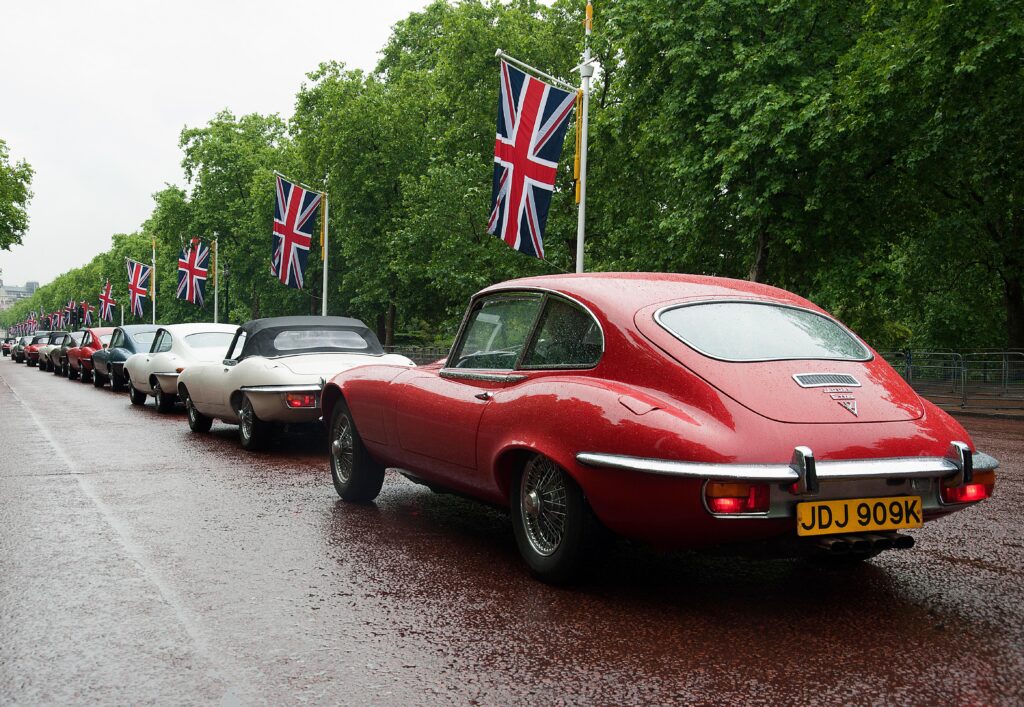
As the most affordable, the Series 3 is worth consideration. By the time it was launched in 1971, the E-type had been in production for a full ten years and, while the Series 2 was an upgrade of the Series 1, the Series 3 was an entirely different animal.
The venerable XK twin-cam straight-six was replaced by a mighty V12 of 5.3 litres, in the process of which the sporty E-type grew up to become a civilised grand tourer with more space and comfort. Yet some Jaguar enthusiasts were dismayed. ‘Soft’ and ‘fat’ were words sometimes used to describe the Series 3 and, yes, it is longer, wider and heavier than previous E-types. But the magnificent V12 engine is a gem that stumps out a useful 276bhp and 304lb ft of torque – leading figures of the day, and much more than the equivalent Mercedes-Benz SL or BMW 3.0 CS could muster.
As the V12 is constructed of aluminium, the Series 3 weighs only about 100kg more than the Series 2 and the independent suspension is much the same, so suggestions that it had become fat and soft are erroneous: it’s actually more powerful and faster than previous Jaguar E-type iterations. Of course, the S3 has power steering as standard and most have automatic transmission too, but find a rare manual, fit some uprated dampers, check the cooling system is up to muster and that the tyres are up to pressure – then blow the doors off earlier E-types with easy disdain.
What about the Lightweight Jaguar E-type?
How did Jaguar make the E-type quick enough to keep up with (and even beat) the racebred Ferrari 250 GTO? Simple. It added lightness. Only two years after Jaguar launched the road car, it followed the precedent set by John Coombs’ racing prototype. When the 12 factory Lightweights appeared, they all employed a much lighter aluminium alloy main body tub, as well as 18-gauge aluminium bonnet, doors and bootlid. Result: the E-type shed around 120kg compared with the standard car – actually making it lighter than the 1078kg of the Ferrari.
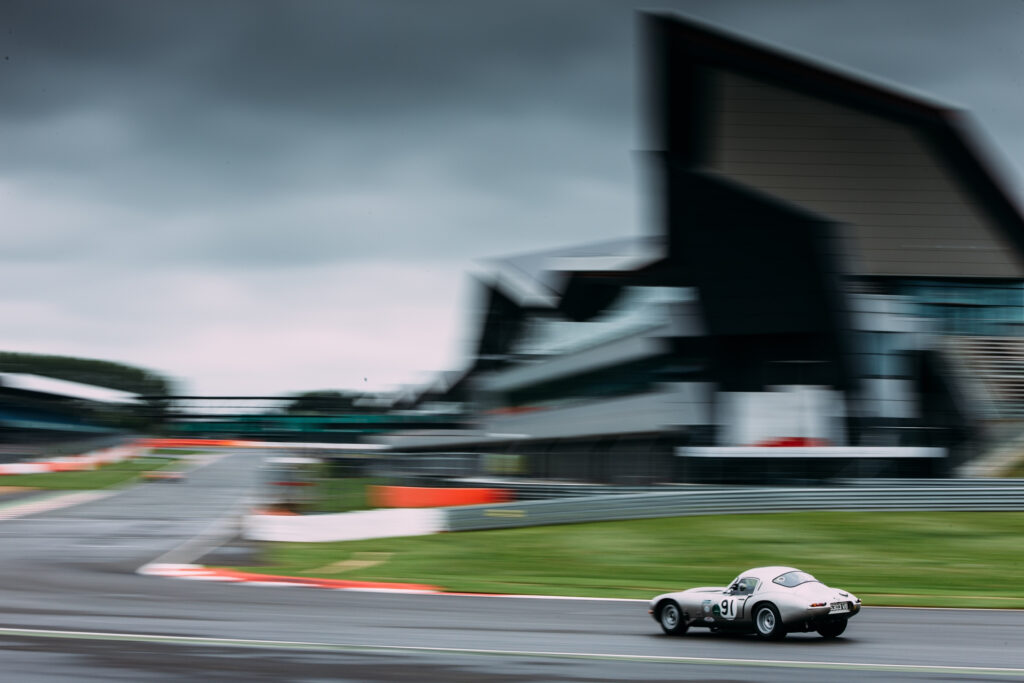
More power followed too, thanks to Lucas fuel injection for the newly dry-sumped engine, which also featured an aluminium block in place of the heavy iron one of the standard car’s, while the race-bred D-type donated its cylinder head. The Manufacturers’ Championship rules changed from sports cars to GTs in 1963, opening the E-type up to a racing world dominated by the GTO, the Chevrolet Corvette and soon the Shelby Cobra. Don’t go looking for headline wins at Le Mans and Sebring in the Lightweight’s racing history. Instead, this car became a class-winning privateer’s dream, outpacing the Ferrari and the ’Vette over shorter distances.
Unfortunately, those alloy-block engines were prone to overheating, so the long-distance races of the Lightweight’s era remained the preserve of its rivals while Jaguar developed the stillborn mid-engined XJ13 racer.
Performance and specs
| Engine | 3781cc, in-line six-cylinder |
| Power | 265bhp @ 5500rpm |
| Torque | 260lb ft @ 4000rpm |
| Transmission | Four-speed manual |
| 0-62mph | 6.9 seconds |
| Top speed | 149mph |
| Fuel consumption | 17.9mpg |
| Price when new | £2098 |
Dimensions and weight
| Wheelbase | 2438mm |
| Length | 4375mm |
| Width | 1657mm |
| Height | 1225mm |
| Weight | 1234kg |
Common problems
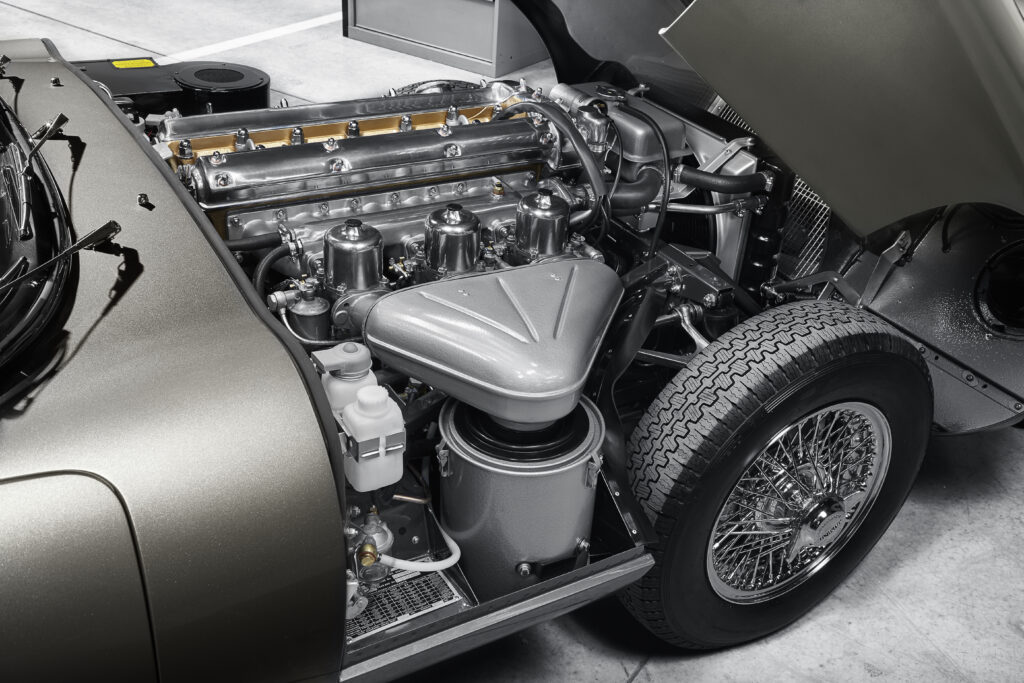
• The 1961-1971 E-type’s iconic XK unit is renowned for its durability as long as it’s looked after. Capable of giving 150,000 miles between rebuilds, the straight-six isn’t especially stressed unless regularly thrashed – and few owners drive hard.
• Get it up to temperature before testing; listen for any knocks or rattles. Check for oil leaks as well as exhaust smoke; expect a few wisps on start-up, but things should soon settle. Once fully warm, look for at least 40psi on the pressure gauge with the engine turning over at 3000rpm.
• Make sure the cooling fan cuts in on tickover. If the temperature gauge needle keeps climbing, the engine may well have overheated once: evidence of a blown head gasket is white ‘mayonnaise’ on the oil filler cap. If the motor is smoking badly or it’s very rattly, it’ll need total rebuild.
• The V12 that arrived in 1971 is an all-time great; properly kept it’ll do 200,000 miles. Poor maintenance leads to overheating, so idle the engine for a few minutes and watch the gauge. Harshness points to previous overheating having distorted the long block and heads. These are alloy, so anti-freeze must be maintained otherwise internal corrosion is guaranteed, leading to a less-efficient cooling system that ensures even worse overheating.
• Low oil pressure at idle isn’t a problem, but check for at least 45lb (preferably 55lb) at 2500rpm. Leaks are common at the rear crankshaft seal; once it’s failed, a full rebuild is needed. Cars that have been run infrequently are especially likely to suffer from this, as the seal dries out then wears more readily.
• The V12 has 20 rubber coolant hoses; the replacement of perished ones is very involved as the water rails and carbs have to be removed. They must also be to the correct reinforced spec; the coolant system runs at 15psi (earlier E-types are just 4 psi).
• The original rubber fuel lines will now be brittle, while the Zenith-Stromberg carbs go out of tune when their diaphragms perish. Rebuilt carbs are the best solution; there are four at £350 each. Incidentally, the V12 happily runs on unleaded, as hardened valve seats were factory fitted.
• Jaguar E-type gearbox and driveline issues? There’s little to worry about here, but listen for clonks that signify worn universal joints or whining that betrays a dodgy diff. Fixing the former is straightforward; the latter is less easy and rather more costly.
• Gearboxes are also strong, but the recalcitrance of the Moss unit on 3.8-litre cars is legendary. It’s noisier than the later one, too, so don’t expect a ‘box that’s especially easy or pleasant to use, particularly when selecting first or reverse.
• Most V12s have a three-speed Borg Warner Model 12 auto, yet the Jaguar four-speed manual is more sought after. They’re both durable, but the latter can suffer from weak synchro on second and third; check for difficulty selecting gears when cold.
• If ratio changes are jerky on the auto, or there’s any slipping, a service involves fresh fluid, filters and band adjustment. For an overhaul, budget £1100. Clutches, diffs and driveshafts are durable, but check for vibrations, clonks or whines.
• What about the suspension, steering and brakes? Jack up each wheel and rock it diagonally, feeling for wear in the bushes and bearings. If there is no play at the rear, the bearings have been set too tight and will probably overheat and fail. There are some in the hub as well as the lower fulcrum; a little play in each of these can lead to what feels like an alarming amount of movement at the wheel, but it should be no more than an eighth of an inch or so.
• Remove the rear wheels and look at the axle cage mountings, which can perish or break. If you’ve already driven the car by now and it feels rather lively at the back, it could be due to rear-wheel steering as a result of the wear. While you’re under there, ensure there’s no oil leaking from the diff onto the inboard rear brakes.
• Any signs of trouble and it’s an axle-out job to sort. If there are creaks from the rear suspension, it’ll be because the lower hub pivots have corroded; if not greased regularly they wear rapidly or seize.
• At the front there shouldn’t be nearly as much play, but don’t be surprised if you can detect a small amount. If it’s bearing wear, that’s easy to sort, but it might be worn lower wishbone balljoints. These act directly on the wishbone, which can be shimmed only so much before replacements are needed at a little over £100 per side.
• The rack-and-pinion steering is reliable, but wear in the column joints is normal; replacement is easy. The brakes should feel very strong, but imbalance is usually caused by that oil on the discs we mentioned.
• The handbrake can also give problems; the self-adjusting mechanism often seizes through lack of greasing. Try to roll the car on a level surface and see if it quickly grinds to a halt; if it does, fixing is simply a case of freeing off and lubing.
• Although steel wheels were standard, chromed wires are now fitted to many V12s. The usual checks for damaged spokes and worn splines are essential; this is especially important with a V12 because of the torque generated.

Jaguar E-type Model history
May 1957: First E-type prototype ‘E1A’ hits the road.
October 1960: Jaguar XK150 production ends.
March 1961: E-type first shown to the press at the Geneva motor show. It went on sale at just £2097 for the roadster and £2196 for the coupe.
October 1964: New 4.2-litre engine launched. Power unchanged but torque figure improved.
March 1966: Larger 2+2 model announced at Geneva motor show.
October 1967: Mildly updated E-type (S1.5) goes on sale.
1968: Series 2 E-Type launched, with many cosmetic changes and refinements brought in to satisfy US customers
March 1971: V12-engined Series 3 Jaguar E-type launched.
September 1974: E-type production ends
Owners clubs, forums and websites
How much to pay for a Jaguar E-type?
Crucially, there’s no such thing as a bargain E-type. It’s quite common for someone to buy an example that’s priced at £20,000 below what would be expected. Then the new owner starts delving and discovers that to get the model up to the standard they were expecting, it needs £50,000 spent on it.
Starting with the Series 1, top condition FHC models cost up to £100,000, although concours examples might go for more. Decent examples can be picked up for between £75,000-£90,000, while rusty projects can still be found for £40,000. The Roadsters are considerably more expensive, topping out at £150,000, with good to great cars able to be picked up for £90,000-£120,000. Budget around £50,000 for a restoration project. Later 4.2-litre cars are generally valued at around the same level. It should be noted that the very earliest examples with external bonnet locks are valued much higher – up to £350k for a roadster.

Moving on to the Series 1.5 and Series 2 cars, for around £75,000, you can get one of the best coupe examples, or pay £120,000 for a top roadster. These models are easier to live with, and represent the most common models, making it a popular choice if you plan on using it regularly. Budget around £40,000-£60,000 for a decent running coupe, and £75,000-£90,000 for the average roadster.
The 2+2 is generally the bargain of the E-type range, and while it does look a little awkward compared to the normal models, it is considerably roomier inside, and prices for good cars range from £30,000-£65,000.
The final V12 models also represent good value, especially in coupe form. Pay anywhere from £15,000 for a project, with decent examples sitting between £30,000-40,000. £60,000 will get you one of the best. Roadsters are actually valued much higher, and you will generally pay twice as much as the equivalent coupe, with the best topping out at about £110,000.
